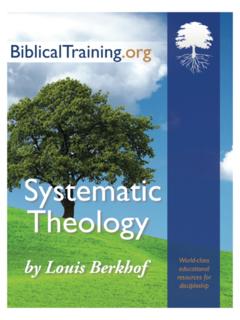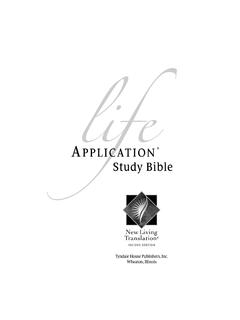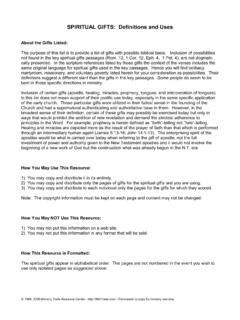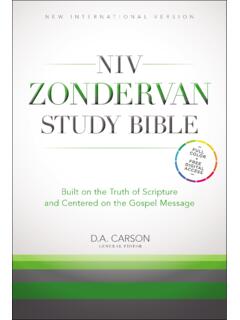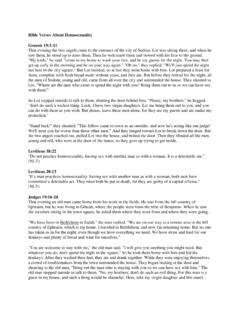Transcription of Systematic Theology, by Louis Berkhof
1 Preface ..17. PART ONE: THE DOCTRINE OF GOD. THE BEING OF GOD. I. The Existence of God ..18. A. Place of the Doctrine of God in Dogmatics B. scripture Proof for the Existence of God C. Denial of the existence of God in its various forms D. The So-called Rational Proofs for the Existence of God. II. The Knowability of God ..30. A. God Incomprehensible but yet Knowable B. Denial of the Knowability of God C. Self-revelation the Prerequisite of all Knowledge of God III. Relation of the Being and Attributes of God ..43. A. The Being of God B. The Possibility of Knowing the Being of God C. The Being of God Revealed in His Attributes IV. The Names of God ..50. A. The Names of God in General B. The Old Testament Names and their Meaning C.
2 The New Testament Names and their Interpretation V. The Attributes of God in General ..55. A. Evaluation of the Terms Used B. Method of determining the attributes of God C. Suggested Divisions of the Attributes VI. The Incommunicable Attributes ..61. A. The Self-Existence of God 2. B. The Immutability of God C. The Infinity of God D. The Unity of God VII. The Communicable Attributes ..69. A. The Spirituality of God B. Intellectual Attributes C. Moral Attributes D. Attributes of Sovereignty VIII. The Holy Trinity ..89. A. The Doctrine of the Trinity in History B. God as Trinity in Unity C. The Three Persons Considered Separately THE WORKS OF GOD. I. The Divine Decrees in General ..108. A. The Doctrine of the Decrees in Theology B.
3 Scriptural Names for the Divine Decrees C. The Nature of the Divine Decrees D. The Characteristics of the Divine Decree E. Objections to the Doctrine of the Decrees II. Predestination ..118. A. The Doctrine of Predestination in History B. Scriptural Terms for Predestination C. The Author and Objects of Predestination D. The Parts of Predestination E. Supra- and Infralapsarianism III. Creation in General ..137. A. The Doctrine of Creation in History 3. B. Scriptural Proof for the Doctrine of Creation C. The Idea of Creation D. Divergent Theories Respecting the Origin of the World IV. Creation of the Spiritual World ..153. A. The Doctrine of the Angels in History B. The Existence of the Angels C. The Nature of the Angels D.
4 The Number and Organization of the Angels E. The Service of the Angels F. The Evil Angels V. Creation of the Material World ..163. A. The Scriptural Account of Creation B. The Hexaemeron, or the Work of the Separate Days VI. Providence ..180. A. Providence in General B. Preservation C. Concurrence D. Government E. Extraordinary Providences or Miracles PART TWO: THE DOCTRINE OF MAN IN RELATION TO GOD. MAN IN HIS ORIGINAL STATE. I. The Origin of Man ..196. A. The Doctrine of Man in Dogmatics. B. Scriptural Account of Origin of Man. C. The Evolutionary Theory of the Origin of Man. D. The Origin of Man and the Unity of the Roce. 4. II. The Constitutional Nature of Man ..206. A. The Constituent Elements of Human Nature.
5 B. The Origin of the Soul in the Individual. III. Man as the Image of God ..219. A. Historical Views of the Image of God in Man. B. Scriptural Data Respecting the Image of God in Man. C. Man as the Image of God. D. The Original Condition of Man as the Image of God. IV. Man in the Covenant of Works ..230. A. The Doctrine of the Covenant of Works in History. B. The Scriptural Foundation for the Doctrine of the Covenant of Works. C. Elements of the Covenant of Works. D. The Present Status of the Covenant of Works. MAN IN THE STATE OF SIN. I. The Origin of Sin ..239. A. Historical Views Respecting the Origin of Sin. B. Scriptural Data Respecting the Origin of Sin. C. The Nature of the First Sin or the Fall of Man.
6 D. The First Sin or the Fall as Occasioned by Temptation. E. The Evolutionary Explanation of the Origin of Sin. F. The Results of the First Sin. II. The Essential Character of Sin ..249. A. Philosophic Theories Respecting the Nature of Evil. B. The Scriptural Idea of Sin. C. The Pelagian View of Sin. D. The Roman Catholic View of Sin. III. The Transmission of Sin ..260. 5. A. Historical Review. B. The Universality of Sin. C. The Connection of Adam's Sin with that of the Race. IV. Sin in the Life of the Human Race ..268. A. Original Sin. B. Actual Sin. V. The Punishment of Sin ..280. A. Natural and positive penalties. B. Nature and Purpose of Punishments. C. The actual penalty of sin. MAN IN THE COVENANT OF GRACE.
7 I. Name and Concept of the Covenant ..288. A. The Name. B. The Concept. II. The Covenant of Redemption ..292. A. Separate Discussion of this Desirable. B. Scriptural Data for the Covenant of Redemption. C. The Son in the Covenant of Redemption. D. Requirements and Promises in the Covenant of Redemption. E. The Relation of this Covenant to the Covenant of Grace. III. Nature of the Covenant of Grace ..300. A. Comparison of the Covenant of Grace and the Covenant of Works. B. The Contracting Parties. C. The Contents of the Covenant of Grace. D. The Characteristics of the Covenant of Grace. E. The Relation of Christ to the Covenant of Grace. IV. The Dual Aspect of the Covenant ..313. 6. A. An External and an Internal Covenant.
8 B. The Essence and the Administration of the Covenant. C. A Conditional and an Absolute Covenant. D. The Covenant as a Purely Legal Relationship and as a Communion of Life. E. Membership in the Covenant as a Legal Relationship. V. The Different Dispensations of the Covenant ..320. A. The Proper Conception of the Different Dispensations. B. The Old Testament Dispensation. C. The New Testament Dispensation. PART THREE: THE DOCTRINE OF THE PERSON and THE WORK OF. CHRIST. THE PERSON OF CHRIST. I. The Doctrine of Christ in History ..333. A. The Relation between Anthropology and Christology. B. The Doctrine of Christ before the Reformation. C. The Doctrine of Christ after the Reformation. II. The Names and Natures of Christ.
9 342. A. The Names of Christ. B. The Natures of Christ. III. The Unipersonality of Christ ..352. A. Statement of the Church's View Respecting the Person of Christ. B. Scriptural Proof for the Unipersonality of Christ. C. The Effects of the Union of the Two Natures in One Person. D. The Unipersonality of Christ a Mystery. E. The Lutheran Doctrine of the Communication of Attributes. F. The Kenosis Doctrine in Various Forms. 7. G. The Theory of Gradual Incarnation. THE STATES OF CHRIST. I. The State of Humiliation ..364. A. Introductory: The Doctrine of the States of Christ in General. B. The State of Humiliation. II. The State of Exaltation ..378. A. General Remarks on the State of Exaltation. B. The Stages of the State of Exaltation.
10 THE OFFICES OF CHRIST. I. Introduction; The Prophetic Office ..391. A. Introductory Remarks on the Offices in General. B. The Prophetic Office. II. The Priestly Office ..397. A. The Scriptural Idea of a Priest. B. The Sacrificial Work of Christ. III. The Cause and Necessity of the Atonement ..404. A. The Moving Cause of the Atonement. B. Historical Views respecting the Necessity of the Atonement. C. Proofs for the Necessity of the Atonement. D. Objections to the Doctrine of the Absolute Necessity of the Atonement. IV. The Nature of the Atonement ..411. A. Statement of the Penal Substitutionary Doctrine of the Atonement. B. Objections to the Satisfaction or Penal Substitutionary Doctrine of the Atonement. V. Divergent Theories of the Atonement.
